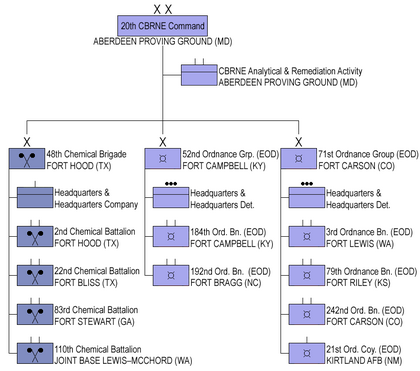
Chemical, biological, radiological, and nuclear defense or Nuclear, biological, and chemical protection is protective measures taken in situations in which chemical, biological, radiological, or nuclear hazards may be present. CBRN defense consists of CBRN passive protection, contamination avoidance, and weapons of mass destruction mitigation.

Yahalom is a sayeret unit of the Israeli Combat Engineering Corps of the Israel Defense Forces (IDF).

Exercise Red Dragon is a recurring civil defense readiness exercise conducted in Fort McCoy, Wisconsin held during the summer, training Army Reserve, National Guard units, and civilian agencies, such as fire departments, police stations, hospitals, and non-governmental organizations to improve the Defense Support of Civil Authorities capabilities for large-scale chemical defense missions.

The United States Army Forces Command (FORSCOM) is the largest United States Army command. It provides expeditionary, regionally engaged, campaign-capable land forces to combatant commanders. Headquartered at Fort Liberty, North Carolina, FORSCOM consists of more than 750,000 active Army, U.S. Army Reserve, and Army National Guard soldiers. FORSCOM was created on 1 July 1973 from the former Continental Army Command (CONARC), who in turn supplanted Army Field Forces and Army Ground Forces.

The 13th Armored Corps Sustainment Command—the "Lucky 13th"—is a U.S. Army modular sustainment command which serves as a forward presence for expeditionary operations for a theater, or in support of a regional combatant commander. Corps Sustainment Commands (CSC), such as the 13th, synchronize distribution of supplies and services within their operational areas and provides distribution oversight. Formed at Fort Cavazos, Texas when the 1st Logistics Command deployed to Vietnam, the organization then known as the 13th Support Brigade was initially responsible for the training of technical services units to assume combat service support missions in Southeast Asia.
11 Explosive Ordnance Disposal and Search Regiment RLC is a specialist regiment of the British Army's Royal Logistic Corps (RLC) responsible for counter terrorist Explosive Ordnance Disposal (EOD), the safe recovery or disposal of conventional munitions. The regiment also has an ammunition inspectorate role supporting the Inspector Explosives (Army). With headquarters in Didcot, the regiment has sub units geographically based throughout the UK to provide a nationwide high readiness response capability in support of the police.

The 52nd Ordnance Group (EOD) is the command and control headquarters for all U.S. Army Explosive Ordnance Disposal (EOD) Battalions and Companies located east of the Mississippi River in the Continental United States (CONUS). The current command team consists of Colonel Matthew L. Kuhns and Command Sergeant Major Isaac J. Allender. Their command covers 184th and 192nd Ordnance Battalion (EOD), as well as the 63rd Chemical Company (CBRN). Subordinate units maintain EOD Response Teams, which evaluate, render safe, and remove conventional, chemical/biological, or nuclear ordnance, or improvised explosive devices (IEDs) which pose an immediate threat to public safety. While subordinate units are trained and equipped for combat operations, they may also support a variety of peacetime missions, to include range surface clearance operations of active U.S. Army installations, EOD and UXO operations in support of civilian law enforcement agencies, and support to the U.S. Secret Service for protection of VIPs.

The 71st Ordnance Group (EOD) ("Raptors") is one of three explosive ordnance disposal groups of the United States Army. On order, the group deploys and conducts operations in support of the Combative Commanders or other government agencies to counter CBRNE and Weapon of Mass Destruction threats.

The 8th Military Police Brigade is a military police brigade of the United States Army based at Schofield Barracks, Hawaii. It is responsible for Army military police units within the United States Indo-Pacific Command Area of Responsibility.
The United States Marine Corps is tasked by Department of Defense directive to "conduct complex expeditionary operations in the urban littorals and other challenging environments" and "conduct amphibious operations, including engagement, crisis response, and power projection operations to assure access." Before 2006, the Marine Corps was the only branch of the Armed Forces that did not have any of its special warfare elements participating in the United States Special Operations Command (USSOCOM), due to confining its special operations capabilities only for the purpose to the Fleet Marine Force.

The 2nd Chemical Battalion is a United States Army chemical unit stationed at Fort Cavazos, Texas, United States, and is part of the 48th Chemical Brigade. The battalion can trace its lineage from the 30th Engineer Regiment and has served in World War I, World War II, Korean War, Operation Desert Storm, and Operation Iraqi Freedom.

The 48th Chemical Brigade is a United States Army brigade located at Fort Cavazos, Texas and subordinate to the 20th Support Command (CBRNE). The 48th Chemical Brigade is the only active duty NBC defense brigade in the Army. The Brigade is tasked to discover, counter, and neutralize chemical, biological or nuclear threats. The Brigade was activated 16 September 2007, under the command of Colonel Vance P. (Phil) Visser and CSM E. Donald Moten.
The 23d CBRN Battalion is a Chemical, biological, radiological, nuclear and high-yield explosives defense battalion of the United States Army, part of the 2ID Sustainment Brigade of the 2nd Infantry Division at Camp Humphreys, Korea.

The 8th Theater Sustainment Command, as the senior Army logistics command in the United States Pacific Command's Area of Responsibility (AOR), provides command and control of all assigned and attached and units under its operational control (OPCON); trains, equips and tailors forces, as required; plans and generates expeditionary combat support/combat service support (CS/CSS) capability; and provides timely and robust support of joint and combined forces across the full spectrum of military operations in order to maintain peace and stability, deter aggression, and fight and win in the Pacific AOR.

The 3rd Expeditionary Sustainment Command is a United States Army unit. It derives its lineage from the 3rd Logistical Command, which was activated in Japan on 19 September 1950 for service in Korea.

The 3rd Ordnance Battalion is a unit of the United States Army currently stationed at Joint Base Lewis–McChord. It is assigned to the 71st Ordnance Group at Fort Carson, Colorado, which is under the 20th Chemical, Biological, Radiological, Nuclear, and Explosive (CBRNE) Command, Aberdeen Proving Grounds, Maryland.

Heidi Jo Hoyle-Cleotelis is a lieutenant general in the United States Army who has served as the deputy chief of staff for logistics of the United States Army since December 2023. She was the 22nd commanding general of the Military Surface Deployment and Distribution Command, serving from June 23, 2020, to July 20, 2022. She previously served as the 41st chief of ordnance and commandant of the United States Army Ordnance School.

The 29 Group, formerly 29 Engineer Brigade, is an engineer formation of the British Army responsible for Explosive Ordnance Disposal and Search. Its headquarters were at Aldershot, now at Didcot.
The 1st Brigade Combat Team "Aegis", Philippine Army, is the Philippine Army's current primary combined arms and rapid deployment unit. It was formed out of a new concept that was among the lessons learned from the Battle of Marawi against terrorist forces in urban environment. It would also be the primary unit for territorial defense.
















